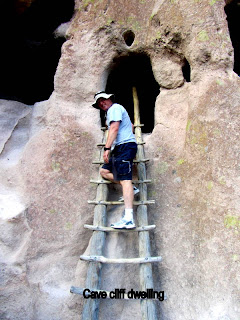Albuquerque happens to be one of the few locations in the Southwest where the old Route 66 still exists with motor courts and diners still in operation. Crusing Route 66 is on Scooter's "bucket list" so when we got to Albuquerque off we went to find Route 66! Scooter went cruising on Route 66 past old motor courts, diners and even an old movie theatre dating back to the 30's and 40's!
Los Alamos was fascinating because of the history of the national laboratory during WWII. The town didn’t even exist until 1943 when the US decided to build an atomic bomb to hopefully end WWII. Los Alamos quickly became the home of some of the most brilliant scientists in the world. Their mission was to build an atomic bomb as quickly as possible and they accomplished the task in 27 months! We visited the old lodge ( formerly an exclusive boys camp ) where Oppenheimer and the other scientists first met to hatch their plan before the “town” of Los Alamos was built to house the 1,000’s of scientists and military who became involved in the project. It was a beautiful old wooden Lodge – very well crafted in the Adirondacks style and now a National Historic Landmark. Close by to Los Alamos were a lot of hot springs, a dormant super volcano 500 times more powerful than Mt Saint Helens and Bandalier, an ancient pueblo settlement with cave like cliff dwellings.
Our campsite in Albuquerque at a lovely casino!
Taos Highlights:
• Rio Grande River Gorge
• Old town plaza
Los Alamos Highlights:
• Learning about the history of the laboratory – particularly the period from 1943 to the end of WWII
• Bandalier National Monument with cave like cliff dwellings
• Soda dam - a dam naturally built from the mineral springs beside the river
• The 14 mile wide caldera of a super volcano with elk grazing in it
Santa Fe Highlights:
• Old town area
Albuquerque Highlights:
• Hopi Indian dances at the Pueblo Cultural Center
• Learning about the history of ballooning at the International Hot Air Balloon Museum and flying a balloon with a simulator - Gary beat me by a long shot!
• Petroglyph National Monument - there are 23,000 petroglyphs in this park!
• Exploring a section of Route 66 and seeing some of the old motor courts, theatres and diners
What's next: Now we start our trek “back east” through Texas, Oklahoma and Arkansas – we hope to stop by the national park in Hot Springs Arkansas. It will be quite a challenge to dodge all of the storms that have been crossing the country lately and have caused so much damage this spring. Rose is a big girl but she’s no match for a tornado! Fingers crossed!!!



















































